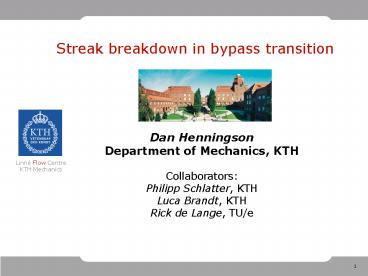Streak breakdown in bypass transition - PowerPoint PPT Presentation
Title:
Streak breakdown in bypass transition
Description:
Title: PowerPoint-presentation Author: PCKG Last modified by: Dan Henningsson Created Date: 6/5/2000 8:53:06 AM Document presentation format: Bildspel p sk rmen – PowerPoint PPT presentation
Number of Views:42
Avg rating:3.0/5.0
Title: Streak breakdown in bypass transition
1
Streak breakdown in bypass transition
Dan Henningson Department of Mechanics,
KTH Collaborators Philipp Schlatter, KTH Luca
Brandt, KTH Rick de Lange, TU/e
2
Bypass transition
- Freestream turbulence induces streaks, which
break down to turbulent spots due to secondary
instability
3
Bypass Transition
moderate to high levels of free-stream turbulence
Non-modal growth of streaks
Secondary instability of streaks
Turbulent spots
Turbulence
Matsubara Alfredsson 2001
Jacobs Durbin 2000 Simulations of bypass
transition, J. Fluid Mech. 428,
185-212. Matsubara Alfredsson 2001 Disturbance
growth in boundary layers subject to free-stream
turbulence, J. Fluid Mech. 430, 149-168. Brandt,
Schlatter Henningson 2004 Transition in
boundary layers subject to free-stream
turbulence, J. Fluid Mech. 517, 167-198. Durbin
Wu 2007 Transition beneath vortical disturbances,
Ann. Rev. Fluid Mech. 39, 107-128. Mans, de Lange
van Steenhoven 2007 Sinuous breakdown in a flat
plate boundary layer exposed to free-stream
turbulence, Phys. Fluids 19, 088101.
4
Streak breakdown
- Eindhoven experiments and KTH simulations show
both sinuous and varicose breakdown - Is this secondary instability of streaks?
Brandt, Schlatter Henningson 2004
Mans, de Lange van Steenhoven 2007
5
Non-modal growth of 3D streaks
Optimize streak output Eout / vortex input Ein
Andersson, Berggren Henningson 1999
6
Nonlinear saturated streaks
A0
A
x
Optimal perturbations used as inflow conditions
with different initial amplitudes A0 in DNS
Brandt Henningson 2002
7
Impulse response using DNS on frozen streak
Fundamental modes A0.36, X630.
z
x
Brandt, Cossu, Chomaz, Huerre Henningson 2003
8
Streak impulse response
Temporal growth rate s traveling at velocity v
A 0.28, 0.31, 0.34, 0.36, 0.38
s
s
Re
A
v
a
- Streak instability is convective!
- Group velocity 0.8
- Growth rate approaches invicid limit as Re
increases
Brandt, Cossu, Chomaz, Huerre Henningson 2003
9
Secondary instability structures
- Non-linear development of impulse response on
spatially evolving streak - Vortex structures at breakdown similar to
breakdown under FST
10
Secondary instability structures
- Non-linear development of impulse response on
spatially evolving streak - Vortex structures at breakdown similar to
breakdown under FST
11
Zaki Durbin model
- Simple model of bypass transition starting with
interacting continuous spectrum modes - Low-frequency penetrating mode high-freq.
non-penetrating mode (streak secondary
instability) - Initial conditions with vrms 2
Zaki Durbin 2005
12
Breakdown in model simulation
- 3D structures show subharmonic sinuous breakdown
- Vortical structures above oscillating low-speed
streak
13
2D cut of breakdown in model
- 2D cut resembles Kelvin-Helmholtz instability
- Erroneously claimed by Durbin Wu to be
responsible for breakdown in recent Annu. Rev.
Fluid Mech. - Sinuous oscillations claimed to be artifact of
plotting
14
Comparison of secondary instability
characteristics
Sinuous instability Wavelength Growthrate Propagation velocity Visualization
Inviscid instability 10.4 0.035
Linear impulse response 10.4 0.032 0.65 0.8 0.95
Non-linear impulse 11 0.025 0.55 0.8 0.95
Zaki-Durbin model 20 0.85
KTH simulations 7 - 11 0.85
TU/e experiments 9 - 16 0.01 0.8
15
Conclusions
- Sinuous breakdown in bypass transition is caused
by secondary instability of streaks - Characteristics of breakdown similar in
experiments and simulations of full bypass
transition, impulse response and Zaki Durbin
model - 2D cuts of 3D simulations have mistakenly been
interpreted as evidence of Kelvin-Helmholtz
instability - Varicose breakdown needs additional
investigations. However, sinuous is more common































